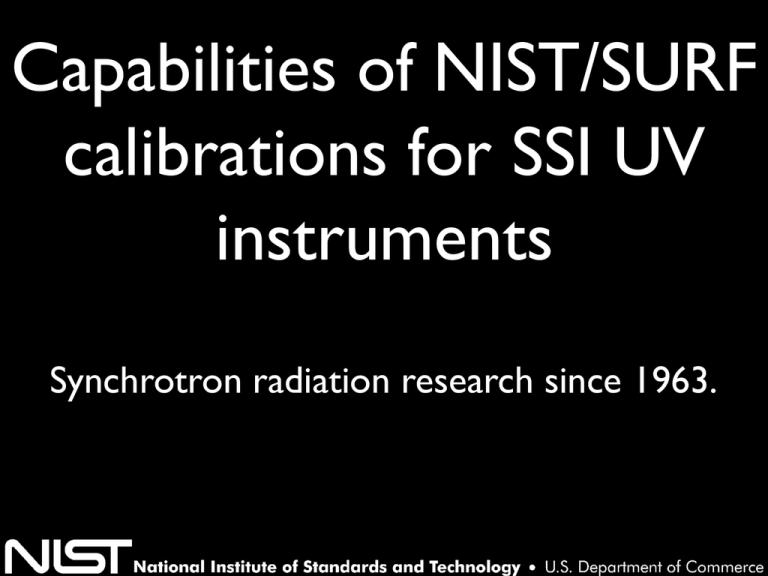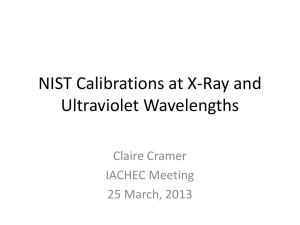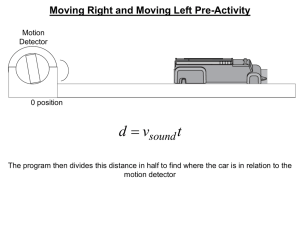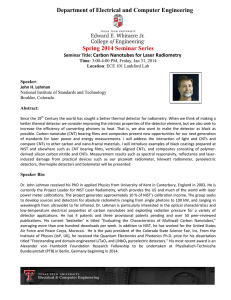Capabilities of NIST/SURF calibrations for SSI UV instruments Synchrotron radiation research since 1963.
advertisement

Capabilities of NIST/SURF calibrations for SSI UV instruments Synchrotron radiation research since 1963. Synchrotron Ultraviolet Radiation Facility Beam current monitor BL-1 BL-3 BL-2 BL-4 Why is Synchrotron Radiation useful? • Electromagnetic radiation emitted by highly relativistic electrons or positrons bend onto an orbit by magnets (Magneto-Bremsstrahlung). • Emitted spectrum: broadband from microwave (harmonics of driving RF field) to x-rays, highly collimated, polarized, calculable. • Output scales with electron beam current. • Extremely clean lightsource operated in oil-free vacuum, which avoids photo-activated polymerization of hydrocarbons. • Synchrotron radiation provides an absolute source! SURF as an Absolute Source • • • • • • Magnetic Flux Density B Radio-frequency νrf Electron Beam Current IB Source Point Distance d Aperture Size ∆X, ∆Y Angle Relative to Orbit Plane ψ0 y Bending Magnet x Electron Orbit ∆ξ ∆ψ/2 A ∆Y ψ0 d ρ Eβ = e0 B c c π ⋅ν rf 2 me ⋅ c − B e ⋅ 0 2 ∆X z E B⋅e = ≈ 744 @ 380 MeV γ = me c 2 π ⋅ν rf ⋅ me Custom-Tailored Output Spectrum Photon Energy hν (eV) 1000 100 EUV 1 DUV VIS Me V 3000 K Blackbody 183 Me V 234 eV eV 284 M 331 M 380 M 105 eV eV 106 416 M 104 103 1 10 Me D2 Lamp eV 78 134 M Radiant Power P (nW) 100 mA, 50 mrad, λ/∆λ=100 107 10 100 V 34 MeV 1000 Photon Wavelength λ (nm) 10000 Combined Relative Standard Uncertainty Photon Energy hν (eV) 101 100 10-1 Σ 10-2 10-3 10 106 105 2· 10-3 IB 10-4 d -4 10-4 ∆Y 10-4 ∆Y 10-5 10-6 10 -7 10 -8 10 -3 B ν RF 100 103 102 101 10-8 10-1 104 101 102 Wavelength λ (nm) 103 100 104 Spectral Irradiance dE(λ)/dλ (nW nm-1 cm-2) 102 SSI E=380 MeV B=1.5142 T νrf=114 MHz IB=300 mA d=10538 mm R = 6.5 mm 103 λ )/d (λ dE E=380 MeV B=1.5142 T νrf=114 MHz IB=1 mA d=10000 mm ∆X=7.071 mm ∆ Y=7.071 mm Relative Standard Uncertainty σE(λ) / E(λ) 104 Absolute Radiometry: Source Based Absolute source based Radiometry: Calibrate different standard sources, spectrometers Storage Ring Monochromator Detector Absolute Radiometry: Source Based Absolute source based Radiometry: Calibrate different standard sources, spectrometers Storage Ring Monochromator Detector Absolute Radiometry: Detector Based Absolute Detector based Radiometry: Calibration of detectors, filter detector packages Detector Under Test DUT Storage Ring Monochromator Absolute Detector AD Absolute Radiometry: Detector Based Absolute Detector based Radiometry: Calibration of detectors, filter detector packages Storage Ring Monochromator Detector Under Test DUT Absolute Detector AD Beamlines at SURF III/NIST # Wavelength range Calibration 1a 13 nm Resist sensitivity (EUV) 1b 5 nm – 20 nm Photoresist prequalification testing (EUV) Optics lifetime (EUV) 2 0.3 nm - 400 nm EUV/UV spectrometer calibrations <1.0 % 3 200 nm – 400 nm 200 nm – 2000 nm Light sources (D2 and other UV) Filtered radiometers (UV, VIS, NIR) <1.0 % <0.5 % 4 140 nm - 320 nm (110 nm – 320 nm) Detector calibrations (DUV, UV) Detector radiation damage (DUV, UV) Optical properties (DUV, UV) < 0.5 % (AXUV) < 1.0 % < 1.0 % 5 100 nm - 400 nm Index measurements (DUV) < 0.0001 % Beam Current Monitor 0.2 % <1% <1% <2% 6 Accuracy 7 7 nm - 35 nm Reflectometry (EUV) Optical properties (EUV) Detector calibrations (EUV) 8 13 nm Optics lifetime(EUV) EUV-induced surface chemistry 9 5 nm - 50 nm Detector calibrations (EUV) <5% 10 550 nm Beam imaging <5% BL-2: UV/EUV Spectrometer Calibrations • Undispersed synchrotron radiation and instrument aperture are used as a standard of irradiance. • Class 10,000 clean room access to large chamber. • Calibrations provided from 2 nm to 400 nm with uncertainty from 0.6% to < 0.1% EVE (Extreme Ultraviolet Variability Experiment) of NASA’s Solar Dynamics Observatory (SDO) Mission prepared for calibration Continuous calibration of twininstruments using rocket underflights BL-2: Large chamber and clean room Houses instrumentation 1 m 1 m 2 m, translates +- 20 cm vertical and horizontal -+ 2.5 yaw pitch Clean oil free vacuum BL-9: EUV Detector Calibrations Monochromator SURF III Radiation Ionization Chamber Monitor Diode Experimental Chamber • Grazing incidence monochromator • SURF used as continuum source from 5 nm to 50 nm • Accuracy – Working standard Photodiodes are calibrated by comparing them to a rare-gas ionization chamber: 2σ ≈5 %. (Not true if ACR is used on BL-7) – Transfer standards Calibrated against a working standard of the same type: 2σ • Capabilities: ≈8 %. – Photodetector Efficiency – Filter Transmission – End-to-End Calibration of Small Instruments – Low-Dose-Rate Radiation Hardness SURF III/NIST Measurement Competences • Detector efficiency – BL-4 ultraviolet, BL-7/BL-9 extreme-ultraviolet • Filter transmission – BL-4 ultraviolet, BL-7/BL-9 extreme-ultraviolet • Mirror reflectivity – BL-4 ultraviolet, BL-7 extreme-ultraviolet • Whole-instrument efficiency (detector-based or source-based) – BL-2 extreme-ultraviolet to visible, BL-3 ultraviolet Transfer of Scale from Photodiode to PMT 10-7 λ = 260 nm, VPMT = 765 V Photodiode Signal Detector Current ID (A) PMT Signal 10-8 10-9 10-10 10-11 10-4 10-3 10-2 10-1 100 Electron Beam Current IB (mA) 101 102 Photomultiplier Tube Uniformity Uniformity Scan LM0159 1.0 0.000 Relative Response 0.8 0.6 0.4 0.2 0.1000 0.2000 0.3000 0.4000 0.5000 0.6000 0.7000 0.8000 -4 -2 0 -10 1.000 4 os it io nX al P -8 -4 -2 Ho riz on t 2 4 6 8 10 12 (mm ) -6 0 2 0.9000 (m m) 14 Ver t ic a l Po sitio nY 0.0 8 6 PMT Absolute Responsivity PMT LM0159 at 765 V 3.5x105 (-3.5,-0.5) (0.5, 8.5) 2.5x105 2.0x105 Vertical Position Y (mm) Responsivity S (A/W) 3.0x105 1.5x105 1.0x10 5 14 0.000 12 0.1000 10 0.2000 0.3000 8 0.4000 6 0.5000 4 0.6000 2 0.7000 0 0.8000 -2 0.9000 1.000 -4 -10 5.0x104 -8 -6 -4 -2 0 2 4 Horizontal Position X (mm) 0.0 200 250 300 350 400 Wavelength λ (nm) 450 500 6 8 Photo Current and Counting Measurements BL-4 @ 2 µA ∼ 80,000 photons / s @ 220 nm -7.0x10-8 1.2x105 -6.0x10-8 Counts 1.0x105 -5.0x10-8 8.0x104 -4.0x10-8 6.0x104 -3.0x10-8 -8 -2.0x10 4.0x104 -1.0x10-8 2.0x104 0.0 0.0 200 250 300 Wavelength λ (nm) 350 PMT Counts C / IB (Hz/µA) PTM Current IPMT / IB (A/µA) Current Transfer of NRL’s x24c to NIST • NRL maintains beamline X24C • Monochromator-based beamline with an absolutecryogenic radiometer – Beamline covers 1 nm to 400 nm with a combination of grazing and normal incidence gratings (can use multilayers) – Several large chambers are available • When NSLS II comes online in 2015 X24C will not be transferred NSLS Beamline Layout and Chambers Loadlock Chamber Monochromator Optics Capabilities of X24C Located at SURF III • Enable cryogenic radiometry with 1% uncertainty by delivering at least 0.5 μW / 100 mA and resolving power of at least 100 from 3.5 nm (354 eV) to 300 nm (4.1 eV). – Covers entire calibration range with state-of-the-art cryogenic radiometry. – Extends wavelength range: current limits are 5 nm (250 eV) and 254 nm (4.9 eV). – Usable over broader wavelength range at somewhat larger uncertainty, including the entire water window between 2.3 nm (O-K; 540 eV) and 4.4 nm (C-K; 280 eV). – Fills gap between 92 nm and 116 nm where there is no current detector standard. • Establish EUV calibration center for detectors and space research instrumentation in a single synchrotron beamline facility at NIST. • Complements existing source-based radiometric capability at SURF III BL-2





